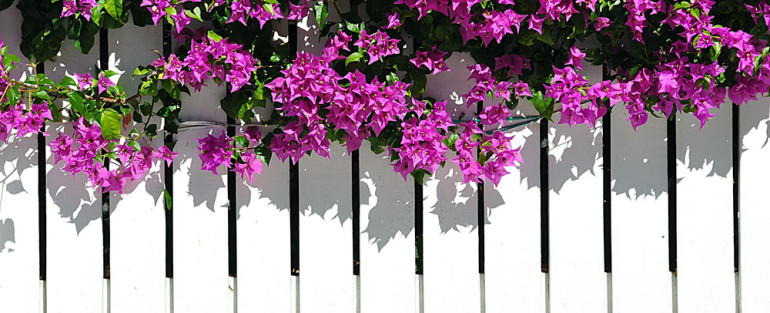
Watch nearly any family movie from the 1940s and at some point, you’re going to see at least one house with a white picket-type fence surrounding it. Watch enough of those movies and you’ll see that, while these fences – at least those in the front yards – may be similar in height and “first glance” appearance, they’re actually very different, using different styles to give each house a unique character.
In fact, fencing has been used for years to enhance homes and define yards – both front and back – and to give that “coming home” feeling. But recently, for many, many years, it seemed that just about the only fence you’d ever see was the so-called stockade style fence – you know the style: Lots of skinny panels in a row, each sporting a pointed peak at the top. As a fence, the stockade served its purpose – it divided spaces and defined yards. But from a stylistic point of view, it didn’t have a whole lot to offer – especially when everyone on the block had one in their yard.
Today, homeowners are breaking free of “stockade syndrome,” choosing fences that use styles, materials, finishes and other design elements and embellishments that not only help make a design and style statement but can also add significant value to your property. If you’re considering a fence for your home, here are a few ideas to help ensure the fence style you choose enhances your home’s style, making it look more welcoming and more attractive:
Gothic: Gothic fencing provides a more traditional “picket look,” with each picket featuring a top edge that that resembles a fleur de lis. Gothic designs are available in wood and vinyl materials, and both materials offer lots of finish options, including solid colors and stains. Gothic styles are available in a variety of heights so you can match front and backyard styles if you choose.
Full or partial lattice: Depending upon the amount of lattice used, this style can be used for contemporary and traditional homes and works well with craftsman-style bungalows as well. Lattice also helps break up the appearance of long expanses of fencing, tricking the eye into “seeing” a larger space.
Iron: Especially popular during the 18th and 19th centuries, iron fencing has experienced a big revival in recent years, especially among those with larger homes seeking to create an “estate” appearance. Paired with a matching gate and depending upon the design, an iron fence makes a bold statement for both contemporary and traditional homes. Because iron fences provide little privacy, they are often used in combination with other fence types to enclose back yards or other private areas.
Horizontal plank: Think about it: Most fencing uses vertical pickets. Turning that tradition on its side makes this fence a popular choice for owners of modern homes as well as ranch-style homes.
Of course, when it comes to selecting a fence, style is only one part of the equation. Today’s fences are available in lots of materials and finishes, which means you can truly personalize your outdoor space. Traditionally, wood has been the most popular choice among consumers for a couple of big reasons: First, wood tends to be less costly than many other materials, and second, it accepts a wide range of finishes, including stains and paints. As a result, depending on the finish you select, wooden fencing can be used to enhance a variety of home styles, from rustic country styles to cottage and Victorian homes.
While wood is amenable to lots of different finishes, it also requires upkeep to maintain its fresh appearance. Unless you like a really natural, rustic appearance, that can mean scraping, sanding and priming to keep it looking its best. Even rustic, natural fencing needs some occasional treatment to keep the wood in good condition and help it last for years and years. That’s why vinyl fencing options have become so popular in recent years. And while early versions of vinyl fencing looked, well, plastic, today’s manufacturing techniques have come a long way to provide realistic-looking fencing that can’t be told apart from its wood counterparts unless you get really, really close – and sometimes, not even then. Even iron fences come in a variety of styles, colors and other finish options.
Finally, no matter what type of fencing you choose, to get the best possible look and ensure its longevity, it’s a good idea to abandon your notions of “do-it-yourself” installation. Putting up a fence may look pretty straightforward – dig some holes, drop in some posts and screw on the horizontal sections, right? – but actually, it’s not nearly that simple. Proper installation requires adequate anchoring of vertical and horizontal supports in addition to precise leveling across often long expanses of ground in order to make sure the fence looks good and performs as it should. Professional installers understand the investment you’ve made, and they have the experience and skills necessary to make sure the fence you choose gives you years and years of enjoyment and also helps boost your property’s overall value.
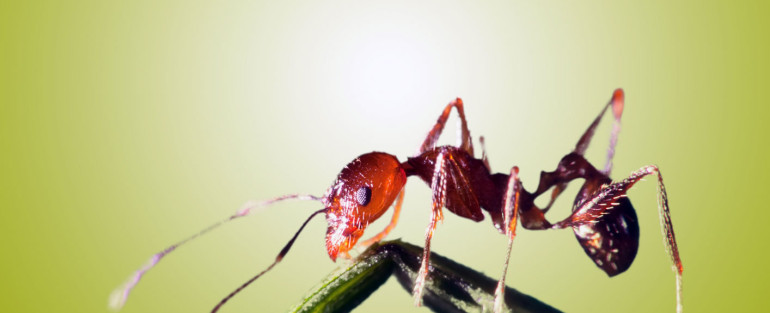
Every fence contractor in Dallas knows that ants swarm in spring. Even worse this year, there is a foreign ant invasion spreading throughout the southeast, replacing local ant populations. These “crazy ants” build colonies 100 times bigger than regular ants, outside and inside houses, in traditional ant locations and in protected areas, like walls and sometimes electronic equipment. Property owners have found them in basements and crawl spaces, air conditioners and computers, and outside in leaf piles and pool pumps. The crazy ant does not respond to regular ant poisons and has no local predators, although it does compete with fire ants.
Texas A&M has identified these ants as Nylanderia fulva, from the area around the border of Brazil and Argentina, according to PLOS ONE online. The Texan invasion apparently started in the ports of Houston, carried there in cargo from South America or Florida, where it is known as the Caribbean crazy ant. It can now be found throughout the southeastern United States.
Crazy ants are about the size of fire ants, but a lighter brown and dull, due to the hair on their stomachs. Rather than marching in straight lines, they run scattered every which way, taking over the living spaces and food sources of local ants, driving them out. They also eat ladybugs and bees. Inside electrical equipment, they cause shorts with the bridges they build between electrical contacts. The ant does not fly during swarming. Colonies spread by inadvertent carriers like cargo boxes, RVs, hay bales, and nursery plants.
N. fulva is now known to be living in at least 21 counties in southeast Texas, as far north as Austin. No one has reported them in Dallas yet, but the Texas Department of Agriculture expects it to be only a matter of time. They and the USDA have deemed the infestation alarming enough that they have set up a special task force to find a way to control the ant and prevent its spread.
Meanwhile, property owners can do their own prevention. L&C Fence & Gate notes that if the colonies start in moist debris piles outside, cleaning up piles can be key to stopping them, especially around the edges of automatic gates, where leaves collect, and in the gate tracks. And if the ants invade enclosed spaces like electronic equipment, then gate gear boxes and pool pumps can be kept cleaned and oiled as a possible deterrent. Although these steps will not stop the ants, they may slow them down enough to at least keep them outside, until researchers can find a longer term solution.

A fence serves a variety of purposes whether it’s using wooden panels for the optimum in privacy, wooden picket fences for a decorative effect or sturdy wrought iron fences for security and enhancement of the home’s exterior and landscaping. Whichever type chosen, periodic maintenance is necessary to keep the fence in shape and looking good.
Wooden Fences
Wooden fences come with several maintenance issues that homeowners should be aware of when choosing this material. Installing a quality fence from the start using the right materials along with standard maintenance can prolong the life of the fence for many years. Consider these tips to maintain a new or existing wooden fence.
● Material – if you are anticipating having a new wooden fence installed, select an appropriate type of wood and ensure the material is labeled pressure treated if it is going to be in contact with the ground. The specific chemicals added to create pressure treated wood protect the fence against moisture and insects especially the posts going directly into the ground that are most susceptible to moisture. Two materials that are good choices for fences as they are resistant to the elements that cause rot and decay and do not need to be pressure treated are cedar and redwood.
● Wood rot and drying – if the wooden panels have not been pre-treated, water from rain and sprinklers will speed up the rotting process. Natural drying and splitting of the wood also takes place over time. These same issues can affect pre-treated panels if not maintained. To prolong the durability of the fence, apply a quality, water-repelling acrylic or oil-based staint to clean, dry panels.
● Vines and foliage– if allowed to grow on or up against untreated wood, plants, shrubs and vines can cause wood rot due to moisture in the plants and a lack of adequate sunlight to keep panels dry. Place plants far enough from the paneling to allow sufficient air flow and sunlight and prune periodically.
● Algae – a natural growth but one that affects the panels. The easiest way to remove algae is with a pressure washer. The force of the water removes the unsightly growth leaving the wood looking like new. Homeowners can rent a pressure washer and do the project themselves or hire a company to do the cleaning. Reapply a coat of water-repelling sealant to the fence once the panels are thoroughly dry. Follow the product instructions for frequency of application.
Wrought Iron Fences
Wrought iron fences provide security while maintaining the open look of your yard. Although sturdy, maintaining the fence helps prevent rust and chipping.
Unlike wooden panels that turn grey and weathered looking if not maintained due to moisture, wrought iron fencing deals with unattractive rust. The build-up detracts from the look of the fence and if left unattended, can weaken the metal.
● Cleaning – clean the fence regularly using a solution of soapy water and a sponge. Visually check for signs of rust and paint bubbling while cleaning.
● Rust removal – for small areas, use a wire brush to scrape rust away from the affected area. After scraping, wipe the entire area down with a damp cloth using the soapy water solution to remove rust residue and debris. Allow fence to dry naturally or wipe it down with dry rags. Apply a metal primer to the clean area according to manufacturer instructions followed by a coat of rust-resistant paint.
● Minor scratches – For minor scratches, use steel wool to work out the scratch then thoroughly clean the area. Let dry then apply several coats of rust-resistant paint to the area.
● Large rust spots – when large or multiple rust spots are detected; it may be time for a complete overhaul of the fence. This entails scraping, cleaning and drying all parts of the fence, applying rust-resistant metal primer followed by a coat, or two, of rust-resistant metal paint.
● Bubbling or flaking paint – if detected, remove it with either a hand held rotary tool and grinder or a wire brush. Sand it down to the bare metal and use a metal filler to address any pitting or holes in the surface. Once dry, clean the fence, dry again then apply a rust-resistant primer followed by two coats of rust-resistant paint to the sanded area.
● Hinges and latches – carefully inspect these areas as both can trap water resulting in rust.
● General care – Keep hedges, vines, shrubs, grasses or any other decorative plants away from the fence to eliminate trapped moisture. Also, keep direct contact with water sprinklers to a minimum.
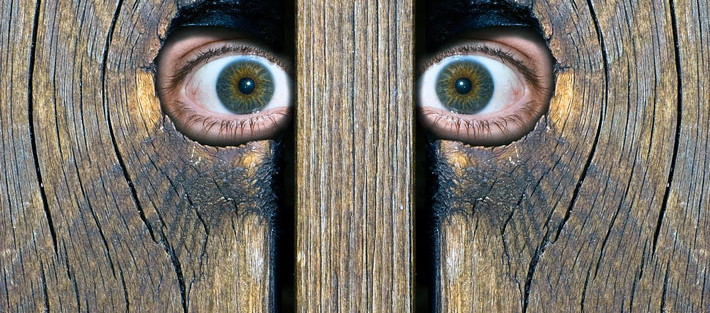
Privacy is very important, especially if you live in an urban area like Dallas, TX. Of course, no matter where you live, a neighborhood snoop can really put a crunch on how you enjoy your property. It can be very annoying to be out with your family, holding a barbeque, swimming in the famous Texas heat, or just sitting on the porch when suddenly you notice the neighborhood snoop staring into the yard. How rude! Pull the shades, close the blinds, or stay inside, those neighbors aren’t going to stop spying. But wait, what about enjoying your yard? There are ways you can keep those nosy neighbors at bay without getting into an argument. By installing a fence you can be passive and aggressive in a way that is safe for everyone.
Bushes for Privacy
There are different options for the homeowner that wants to preserve their privacy. Some people choose to plant bushes. The problem with bushes is that they can become unruly. While you might be fine with a high line of bushes, your neighbors might not be as happy when the bushes grow too large. Keeping bushes trimmed can be quite a job. Once bushes reach a certain height they become leggy and if one of your problems are wandering animals, such as dogs and cats, they can walk right under the bushes.
Tree Fences
Trees are sometimes advertised in gardening catalogs as a great way to secure your privacy from prying neighbors. Most of the trees in the tree ‘fence’ advertising are fast growing. However, not all areas will support the best growth for these types of trees. In Texas the heat may cause them to be scraggly and weak. What Texan wants a pitiful looking line of trees surrounding their property? This is the home of ‘big, bigger, biggest’ – don’t get stuck with wimpy trees.
Privacy Fencing
Privacy fencing is one of the most attractive ways you can envelop your home in a cocoon of privacy. You’ll avoid critters that are attracted to bushes. Western Red Cedar fencing is the most common and cost effective privacy fence you can have. Cost effective because of the long life this lumber affords to your project, expect well over 20 years You should use steel posts and can even cover the metal posts with cedar to soften the look. Attractive fencing can add beauty and value to your home, which makes such a fence an investment for your future – home equity is one of the most important aspects of property ownership.

Summer is a time of scorching heat in Texas. Whether you have been living in the state for years or just moved away from another area, Texas has an extreme range of temperatures from well over 100F in the summer to below freezing in the winter for some areas. Your lawn needs to be prepared for these extremes.
So, what can you do to get your lawn ready, plus enjoy the summer weather to the fullest? Maybe you need to look into gate repair for your garden or lawn gates, set up a natural pond, or install a patio. Whatever you need, you should get started now.
Get Started Early
You can begin by choosing the best grass type for Texas. Your local garden supply store will have seed that is appropriate for your area. Ordering from online sources or catalogs can be dicey as quite a few of the most lush looking varieties will wither in the Texas sun. Prepare your lawn early by planting the right grass seed.
In the fall you can prepare for the next summer by putting one last fertilizer application on before the growing season ends. You may use chemical fertilizer or compost. Using compost has the added benefit of rotting throughout the winter and spring, this releases nutrients over time and can feed your lawn for months.
Watering
We all know that Texas is hot. The beating sun can kill even hardy grass types when there are extended periods without rain. Watering your lawn is an important part of keeping it healthy throughout the summer. Due to drought conditions, this can be a problem in Dallas. Many times there are water restrictions put in place during the hottest part of the summer.
Another thing to keep in mind is to water around the fence, just as you would a foundation. By watering around the fence line you’re helping to keep the gate in adjustment and prevent fence posts from moving. You never want to go from drought conditions around your fence to boggy water-ladened swamp, keep a nice moderate soil saturation for the best results. This will keep your fence and gate investment protected.
One way to beat the water restrictions is to install rain barrels and gray water disposal. Gray water is the water left over from washing clothes, bathing, and doing dishes. You can divert this water from your septic system into a large container system. This water needs to be filtered before it can be used in the lawn. Sand filters can be used before the water reaches the holding tanks or directly after leaving the tank. Gray water is a valuable resource when there are water use restrictions – you can have a lush lawn and garden even in the hottest days of summer.
Decoration and Privacy
While you want your lawn to be gorgeous, grass is only one consideration. Flowers add beauty to your lawn. As with grass, choose flowers that are suited for your area. Many beautiful flowers will not live even a few hours in the mid-day heat of high summer in Texas, even with intense watering. Look for native plants – these Texas and SouthWestern native plants will give your lawn a gorgeous look and will come back year after year.
A wooden fence around your yard or back patio can give your lawn privacy and beauty. You can build your own fence or use a fence contractor for the fastest, professional installation. Nosy neighbors or wandering animals can ruin the nicest of lawns – you can’t enjoy your yard when people are staring or dogs are digging holes! Such a fence can also provide safety from wandering coyotes, even in urban areas these wild canines cause problems. If you already have a fence, check your gates. A strong gate can deter animals and burglars. If it isn’t strong enough, consider a gate service for repair or installation.
You don’t need to put in a lot of work all at once to keep your lawn in great shape. You can spend a few weekends getting your property in shape or spread the work out over several months. A professional service can help with clearing property, installing fences or patios, and almost any other yard project you need completed to get your yard in shape for the Texas summer.
You’ll be happy with the final results if you spend a lot of time planning and a little elbow grease on your preparations. When you’re enjoying your pool, barbeque, or just sitting in the shade with a glass of iced tea, you’ll be glad you prepared ahead.

If you have animal companions, you know the importance of allowing them access to the outdoors to run, play, investigate their yards and take in fresh air. You are probably also concerned with the safety issues involved with keeping them confined to your property while keeping uninvited animal guests out.
Properly installed, intelligently selected fencing around your outdoor spaces makes all the difference in allowing a pet access to enjoy sufficient exercise outdoors, and a confined, unhappy animal. There are many different animal-oriented fencing options available, each with its own benefits and drawbacks. Here are some fencing basics to help you choose the right fencing choice for you, your pet and your property.
Dogs
Many dog owners don’t feel they have the time or ability to take their pet on multiple daily walks, and most cities and towns have leash laws and ordinances prohibiting dogs from running loose without supervision. Chaining is never the answer, but there are a few fencing options available:
- Dog runs – Typically constructed from chain-link fencing, they provide an outdoor exercise area and visual access. Newer innovations feature an attractive vinyl coating as well as powder coated pipe to dress up the look of boring galvanized chain-link fencing.
- Invisible fencing – Requires the use of installed underground wires around your property perimeter, transmitters and clunky collars. When your dog approaches the boundary, they are given a static energy pulse, mild shock, citronella spray or unpleasant noise. After time, some dogs become used to the shocks, noise or smell, and it no longer serves as a deterrent. Some city ordinances ban electronic containment systems, or require special permits. The main flaw in invisible fencing is that while it may keep your pet contained, it does not prevent other animals or people (who may do your pet harm) from entering your property.
- Traditional fencing — The best overall solution for most dogs are fences made out of solid wood materials. They secure your dog, keep out other people and animals, and are an attractive addition to your landscape. In addition, they prevent your dog from looking beyond his immediate territory, which is helpful for dogs more prone to barking. Tall privacy fences are suitable for large jump-happy breeds, and they can be installed with a dig-proof footing for thwarting diggers.
Cats
Most people would like to allow their cats outside access, but worry about roaming issues and predators. However, keeping your cat indoors can result in a fat cat. Over 50 percent of felines were found to be overweight or obese in a study by the APOP (Association for Pet Obesity Prevention) in 2011. Inactivity predisposes your cat to sedentary obesity and diabetes. Better solutions for cats are:
- Vinyl-coated chain link – Allows your cat free reign of your yard. They look good, provide safety, and are difficult to climb. Combined with a cat-proof fence conversion system, you never have to worry about Fluffy wandering the neighborhood. The conversion systems easily attach to chain-link fences with bolts, and feature a spring-loaded arm and baffle that folds under your cat’s weight, to deter even the wiliest escape artist.
- Wood fences – Best for homes with a cat and dog duo. They are easily fitted with a fence conversion kit. An added plus is that they serve double duty as a scratching post, to spare your furniture.
When shopping for fencing for your companion animals, be sure to work with an experienced fencing contractor who will consider your needs, preferences and budget to arrive at the best solution for your pet-friendly fencing project.
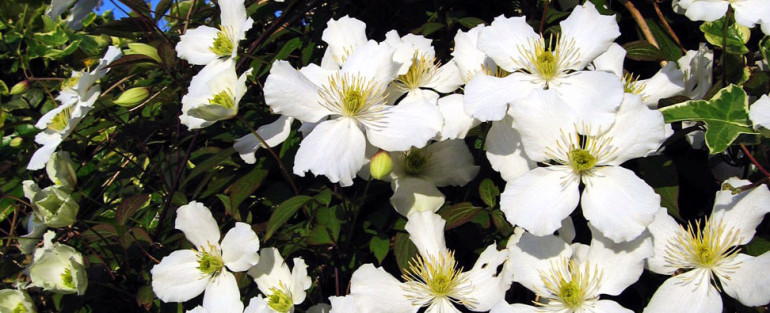
While there are many plants you don’t want to go around fencing, ones that have roots that can destroy the fence, there are still many pretty flowers and plants that can go around the fence area. Here are some ideas that can work well in flower beds that are near fencing.
Clematis
With over 400 cultivars, you’re bound to find one of these that will work for you. Semi-woody vines have saucer-shaped flowers in any color you care to choose. Have these trail along the pickets of the fence for the most dramatic effect.
Cherokee Rose
This climbing rose has a wonderful cream-white color on vine-like canes. It produces single flowers with glossy light-green leaves. These are a wonderful addition to have on dark wood or white fencing.
Russian Sage
Grey-white stems with silver-grey leaves and lavender flowers. This subshrub has a great aroma and can be a lovely addition to fencing that is around a patio, so guests can smell the richness of the plant.
Black-eyed Susan
Yellow-orange blooms with a dark center stand erect and daisy-like on stems. This is a summertime favorite and one that will work with just about any other type of plant. This is a good addition for a border plant and for those that like the classic feel of a daisy-like bloom.
Flowers and plants around a fence can make a dramatic statement and really add life to the straight line of a fence. It makes landscaping easier when you don’t have to mow near the fence, and it can be a nice visual to help increase the value of your home. If you don’t have flower beds around your Dallas, Texas fencing, give some of these great choices a try.

Your property is a huge investment and it is only natural that you want to protect and beautify it. Having a fence installed is an essential step in security and a large investment for an owner. Choosing the right fence contractor for the job is vital to prevent complications from developing at any point during, or following, the installation.
There are seven basic approaches that can protect you, your property, and your investment.
Research
Before interviewing any fence contractor you can learn a great deal about the individual or company that you are dealing with through your first encounter. Here are a few things to be concerned with:
● When you call the office, there should never be a generic answer to the call. Any professional company will have a professional answer to their phones which should include the name of the company.
● Any advertising should include a verifiable address. Many fly-by-night services will not have a legitimate address to be traced to.
● Never hesitate to check listings with the Better Business Bureau. This is a free service to aid consumers.
● While it is an initial jerk reaction for individuals who are looking at listings to select the first company they come to. Keep in mind that a company that is listed at the top of a search or a phone list, is not an indicator of their ability.
Red Flags for Interview
As you work through the process of finding your contractor some additional items you should keep in mind include:
● A contractor which requires you make an immediate decision should make you nervous.
● Anytime a professional pressures you to pay cash is never a good sign. There are some legitimate businesses which will provide their customers with a cash discount, which should not be confused with the contractor which requires you to pay cash only.
● Any professional contractor will give you a written estimate for the services you are requesting, if they will not give you one, you do not want to do business with them.
Necessary Questions
Some other details to bring up as you speak with your fence contractor, or potential contractor include:
● What materials do they recommend and why?
● If you are replacing, or repairing your fencing ask what their procedures include.
● What is the track record for the contractor staying within the estimate amount?
● How often do they finish on time?
● Is there any type of warranty on the work they provide?
● Will any of the materials you currently have be able to be used or recycled in the installation/repair?
Always speak to multiple contractors and get their written estimates.
Planning 1-2-3
1. As you make your plans for your fence you will need to make an assessment of how much you are willing to spend for the materials and labor. Once you have made these decisions you will need to share the information with the fence contractor and then confirm that they will be able to work within these guidelines.
2. Determine where you want your fence to run. Will it incorporate the entire land or only a portion? Do you want to include different types of fencing, such as one close to the residence and a different form further away.
3. Look at magazines and other properties to get an idea of what you want, give the pictures to the fence contractor to develop a clear idea of what you want. Never be shy about asking for design ideas or help.
Establish Timeline and Contact Person
As you move forward, you will want a definitive timeline of when the work is expected to be completed. Determine if there will be any discounts for delays or inability to reach the set goals.
On large jobs there are often multiple people that will be accomplishing the work, find out who the direct responsible is, in the event of any problems or questions.
Guarantees
Some contractors will provide a guarantee on their work. Ask about any guarantees that the company provides for the job.
Depending upon the materials you select for your fencing, there may also be a warranty on it. Many manufacturers of automatic gates often offer extended warranties of up to 7 years.
Payment
You will need to ask what the company policy is regarding the work. Some companies require full payment up front, others partial payment, or at the end of the job.
Will they finance? Do they accept credit cards, and which ones?
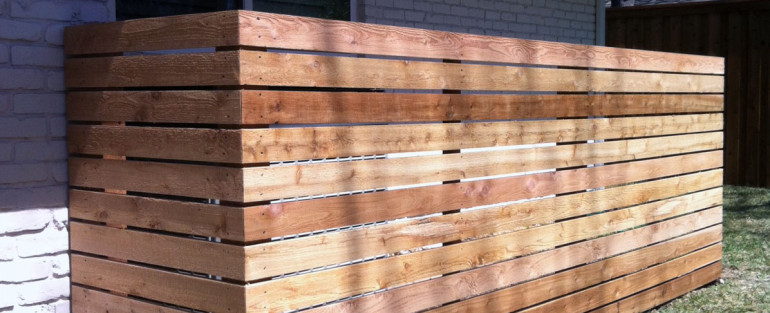
As spring rolls around there is always a long list of things that need to be addressed to get taken care of for the new year. House repairs and maintenance, even lawn care. People often forget about the needs of their fence. No matter what the materials are that you choose to use in the fence structure, whether it is automated or manual, there are a few things to do which will extend the life of your investment.
Your first step is to always do a thorough inspection of the entire fence. You need to look for any areas that are compromised, which may include rot, damage, leaning, and weak points. This includes the posts, pickets, wiring, and gate closure or function. Be aware of any places where the screws, wiring, or nails need to be replaced or tightened.
Once you have performed your inspection you will need to make the necessary plans to repair or replace any areas that are no longer stable. Addressing larger sections and posts may require professional assistance to prevent damaging other sections.
If your fence includes brick and mortar you will need to look for any cracks that have developed or any locations where the stone or brick has come loose. Depending upon the size of the crack, you can often fill this in yourself, however, larger problems should be taken care of by a professional.
We do not recommend adjusting or repairing any electrical features, such as lighting affixed to your fence. This might turn into a dangerous exercise and it is easier to have someone with experience take care of this.
When it comes to gates you need to pay close attention. Depending upon the type of gate you have installed, it may require the hinges and/or wheels to be lubricated. This will aid in keeping the gate functioning smoothly and in the case of automated gate systems it can prevent causing damage to the mechanical devices attached to it, which could lead up to substantial costs in the future.
It’s also important to check the pulley system which moves your gate. The wiring should not be frayed in any way.
If you have elected to use a sliding gate you should take the time to assess the area the gate is being drawn across. Surfaces that are paved should be repaired if there are cracks or holes, and dirt locations should be kept as level as possible. An automatic gate will also require you to clear any debris or obstruction along the path which it is being drawn across. You may need to trim trees or bushes to prevent interference with the proper function of the gate.
Your fence plays an important role in the security of your property, it was a considerable and worthwhile investment and providing some basic spring maintenance will keep it beautiful and functional for years to come.



Recent Comments